Abstract
1. The binocular co-ordination of human horizontal saccades was analysed for the first time systematically over the full oculomotor range with a precise and accurate scleral sensor coil technique. Effects of amplitude (1.25-80 deg), direction (adduction vs. abduction and centrifugal vs. centripetal) and eccentricity (symmetrical about primary or between primary and secondary positions) were systematically investigated in three subjects). 2. To minimize extraneous effects of stimulus presentation on the programming of saccades, subjects were instructed to voluntarily change their gaze between two continuously visible targets. These were positioned on an iso-vergence locus, and thus contained no stimulus for disjunctive eye movements. 3. Under these conditions the amplitudes of the primary saccades of the two eyes were remarkably accurate; undershooting of the target by about 0.5 deg (independent of amplitude in the range 10-70 deg) was typical. This finding contrasts with the undershooting by about 10% described in the literature as characteristic for other stimulus conditions. 4. Saccadic peak velocities saturated at a mean asymptotic level of 502 +/- 32 (S.D.) deg/s for saccades of 40 deg and larger. The duration was linearly related to amplitude for saccades up to 50 deg; for saccades of larger sizes the duration increased progressively more steeply. Skewness values (acceleration time as a fraction of total saccadic duration) decreased from about 0.45 for saccades up to 10 deg to about 0.20 for saccades of 50 deg and larger. 5. Binocular saccades showed an abduction-adduction asymmetry and were not well yoked dynamically. The saccades of the abducting eye consistently had a larger size, a higher peak velocity, a shorter duration and were more skewed than the concomitant adducting saccades of the fellow eye. As a result, the eyes diverged transiently by as much as 3 deg during horizontal saccades. 6. Saccades also showed a marked centrifugal-centripetal asymmetry. Peak velocities of saccades towards the primary position were about 10% higher than peak velocities of corresponding centrifugal saccades. 7. These directional asymmetries were the main source of variability in the pool of saccades. In comparison, intra- and intersubject variability was minor in our sample. 8. Post-saccadic drift consisted of a vergence and a version component. The vergence component of this drift was a continuation of the vergence movement occurring during saccades. The version component, generally smaller than the vergence component, was directed towards the target position.(ABSTRACT TRUNCATED AT 400 WORDS)
Full text
PDF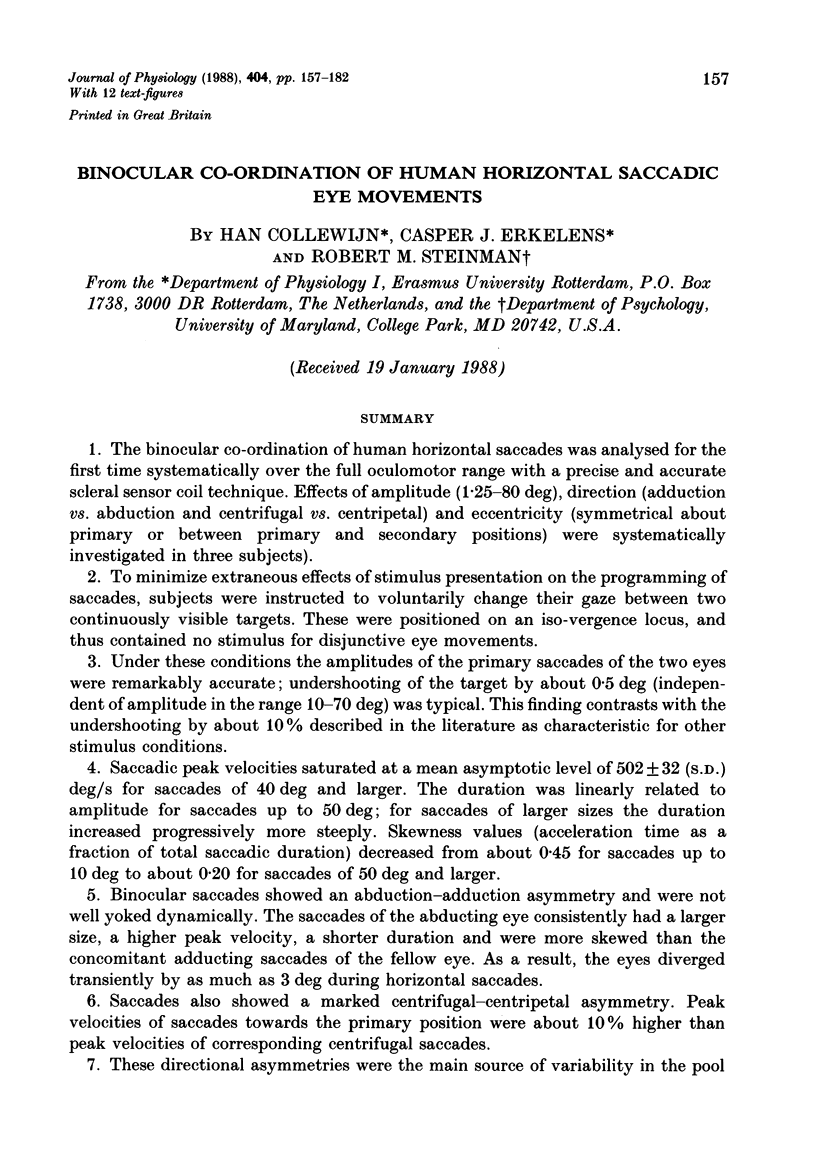

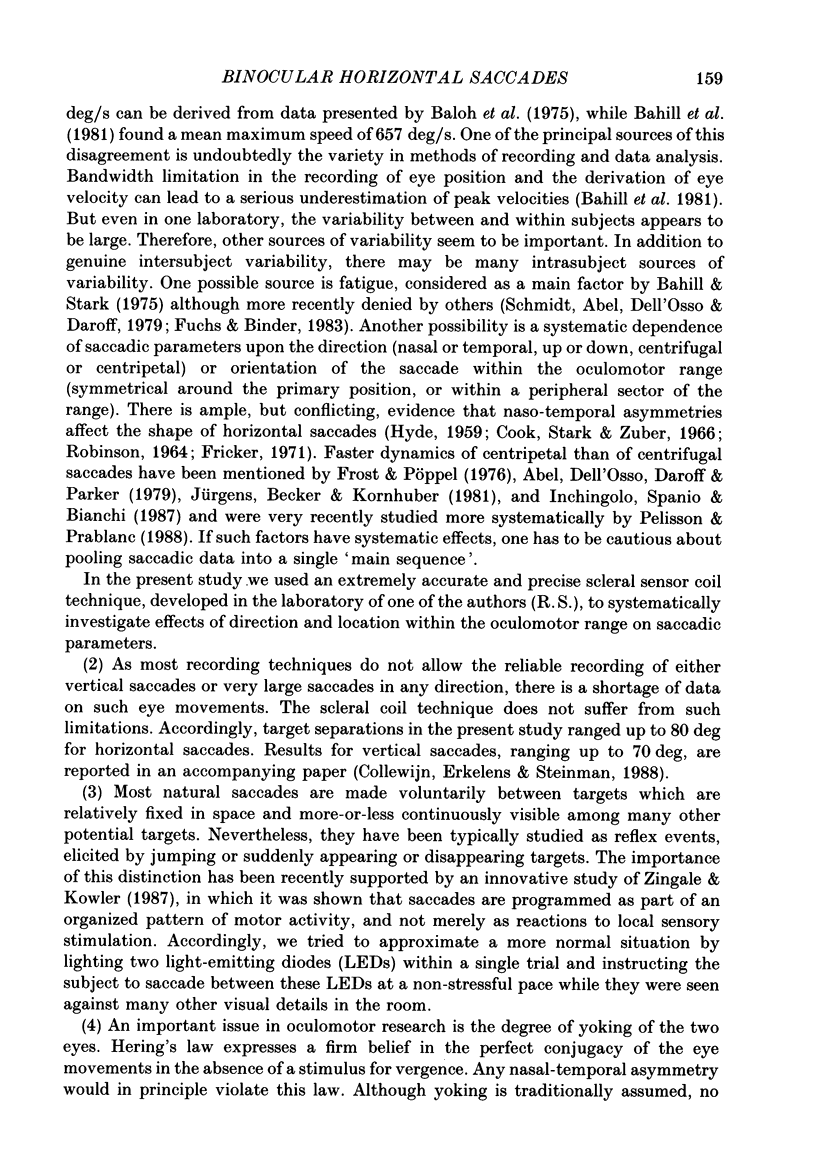
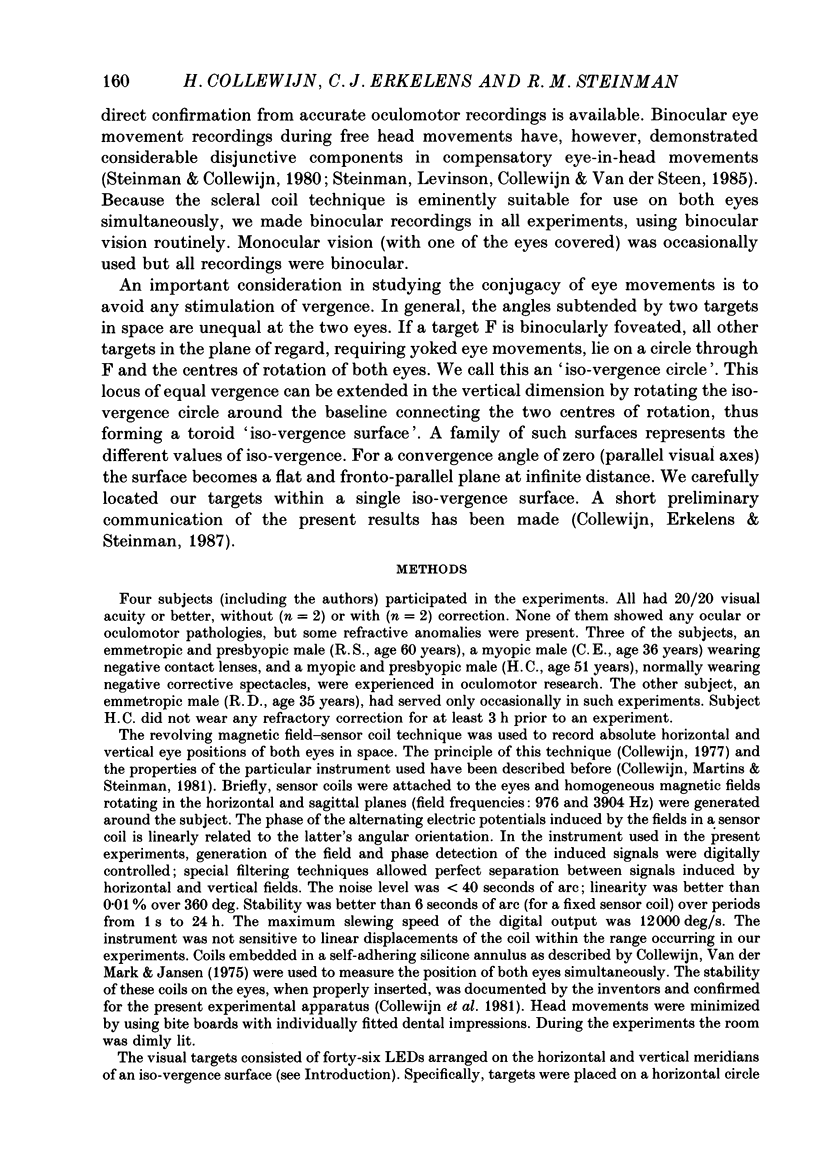

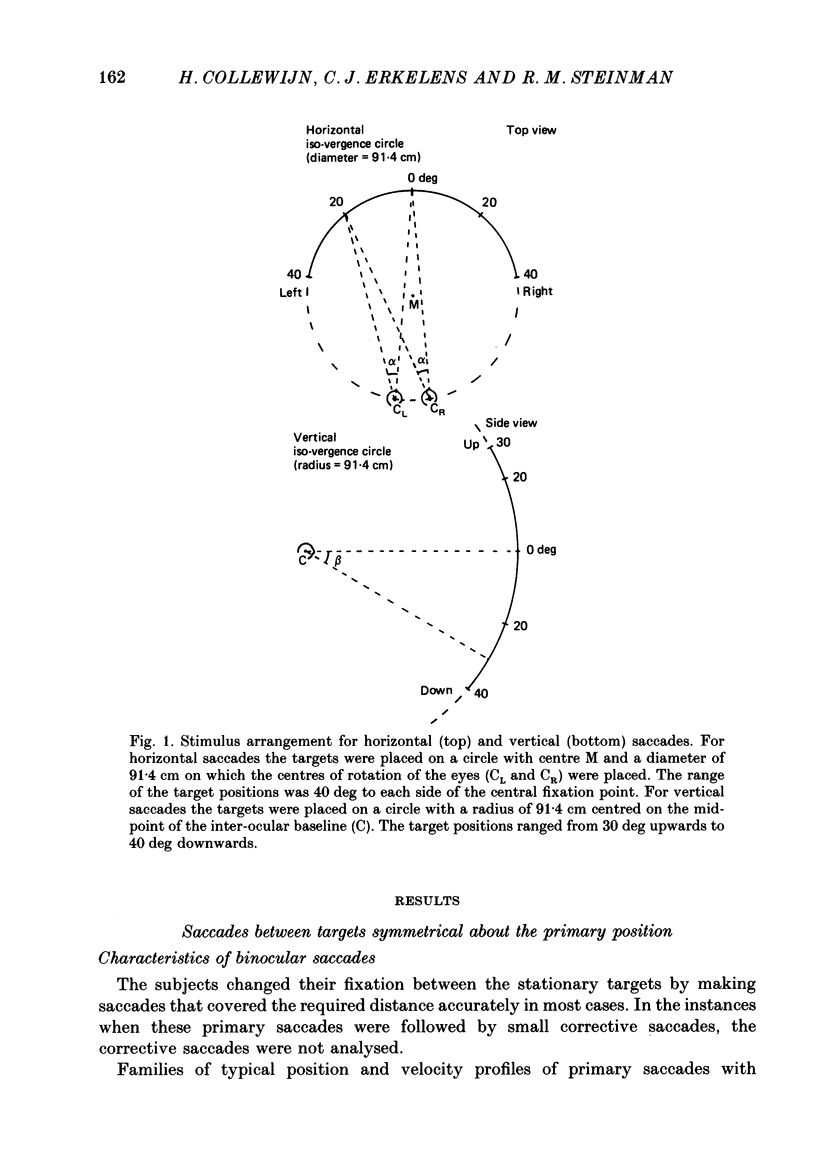

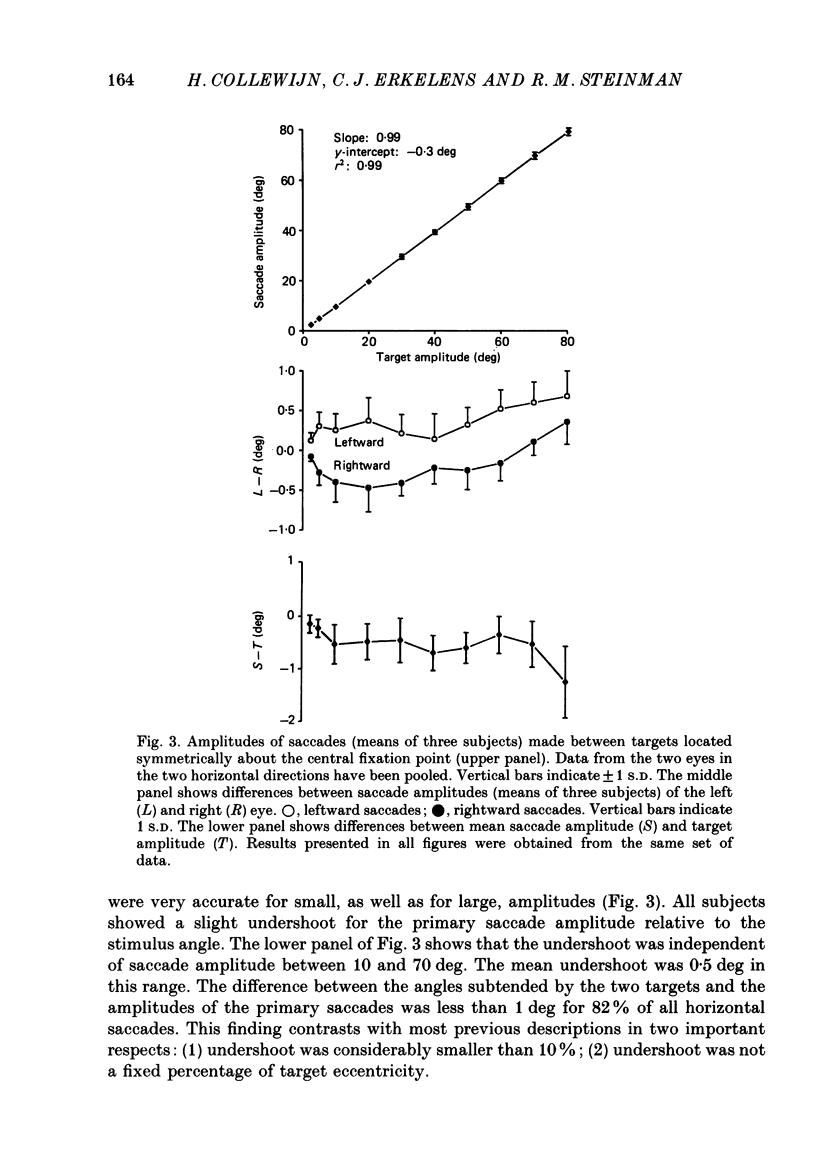
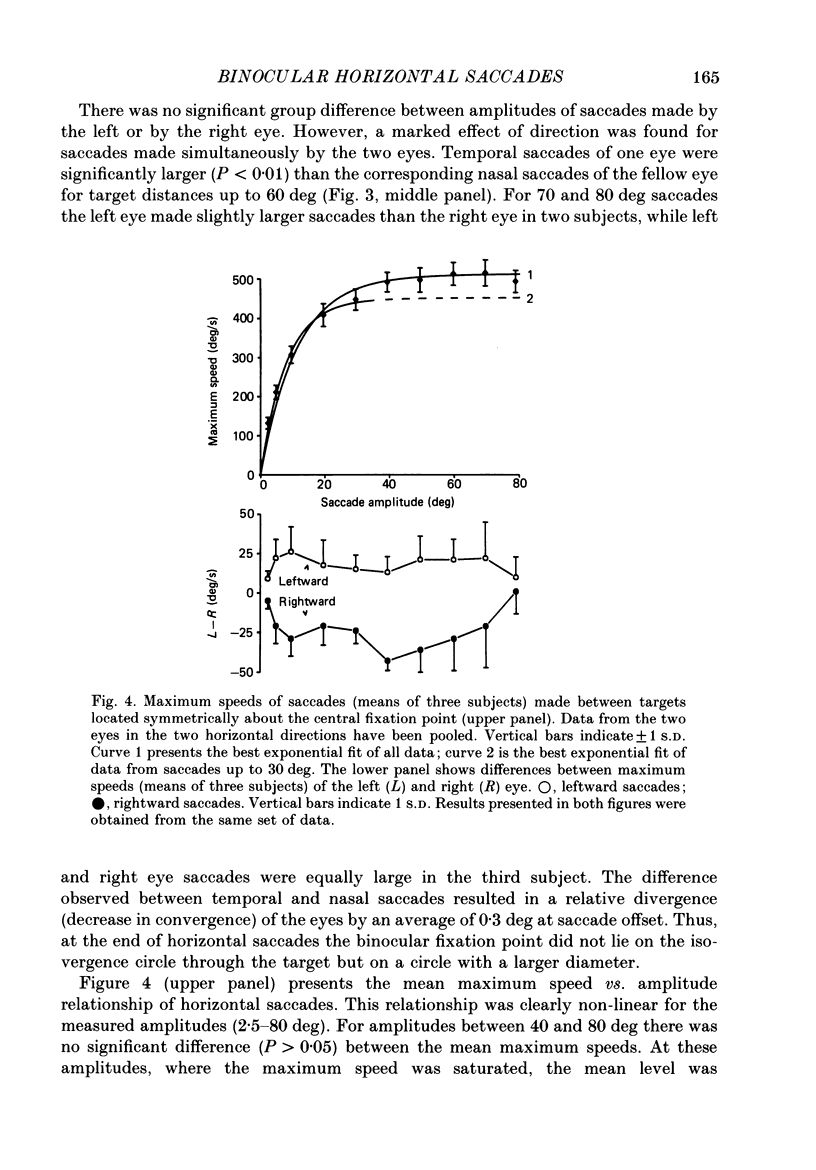
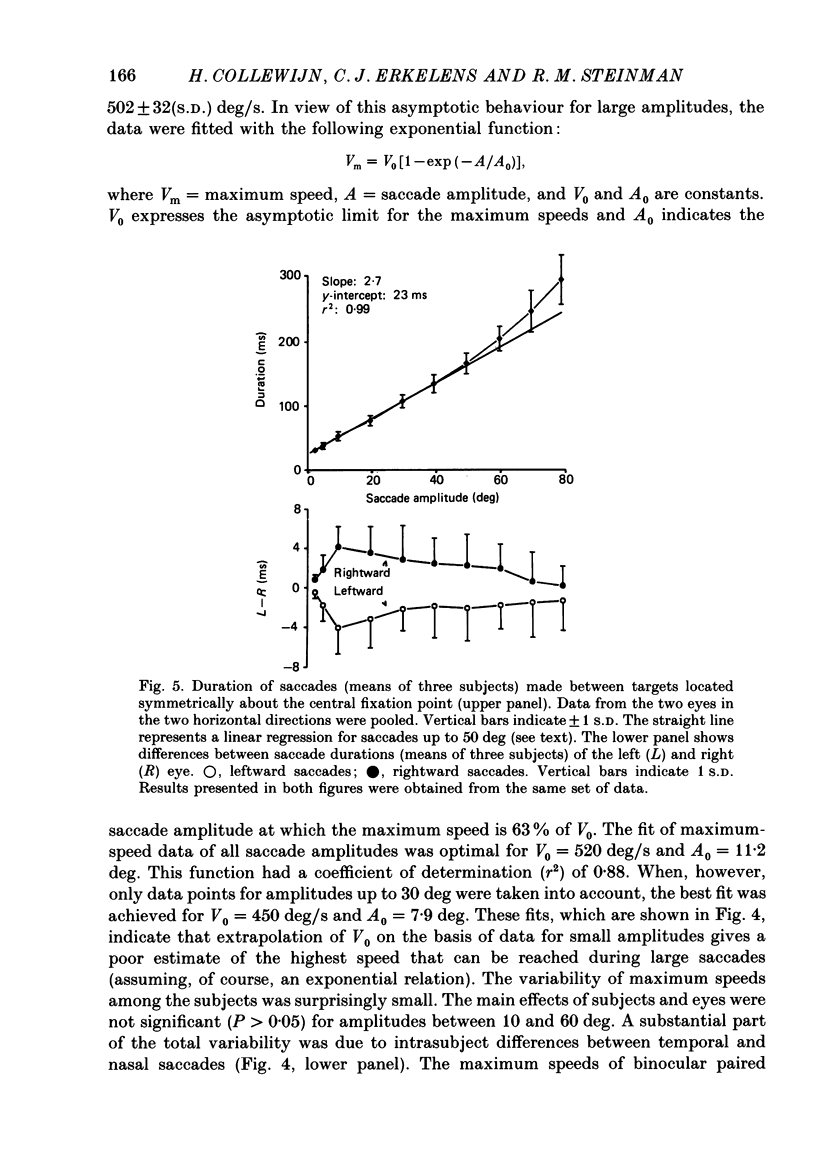
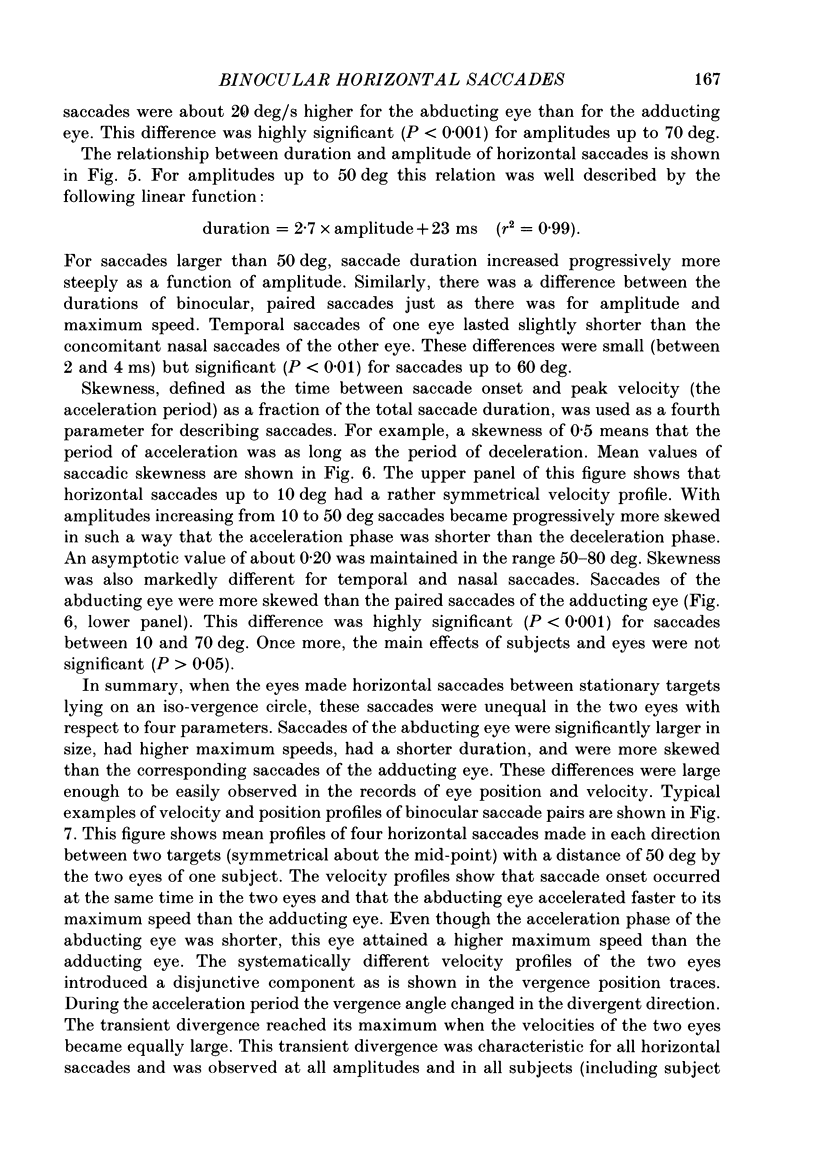

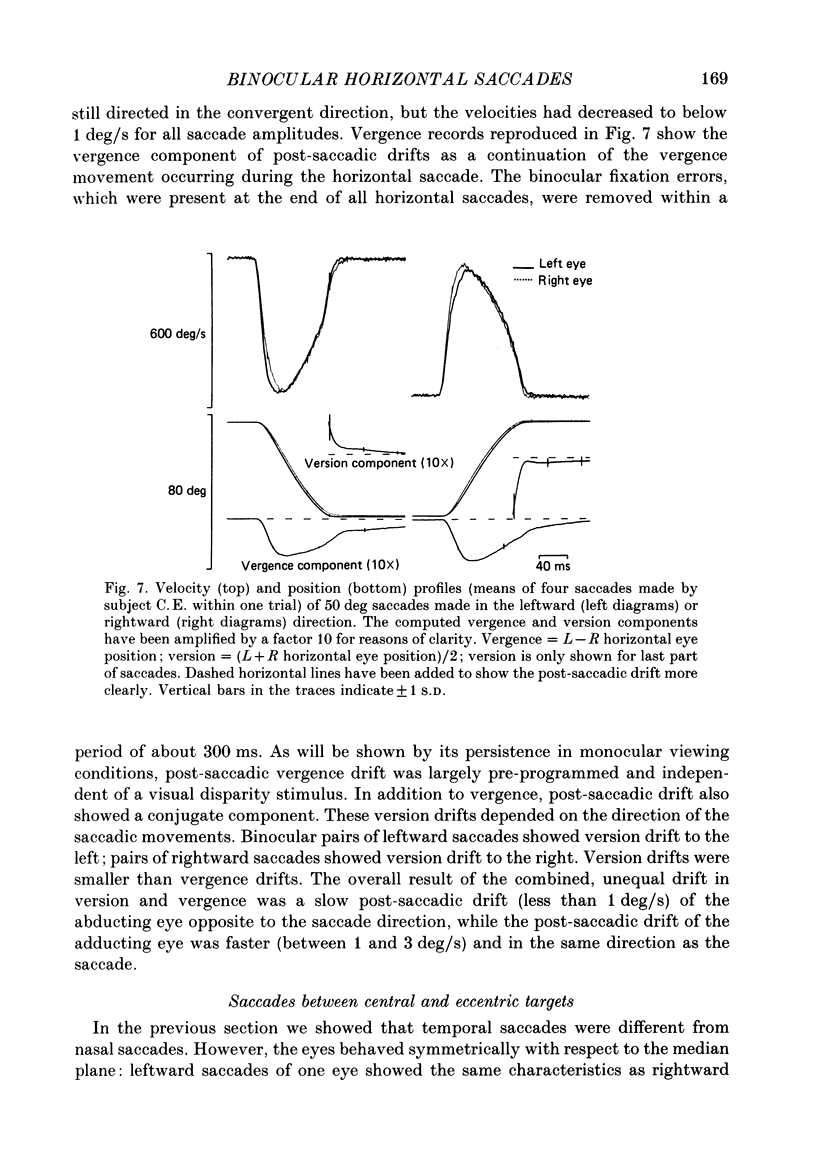
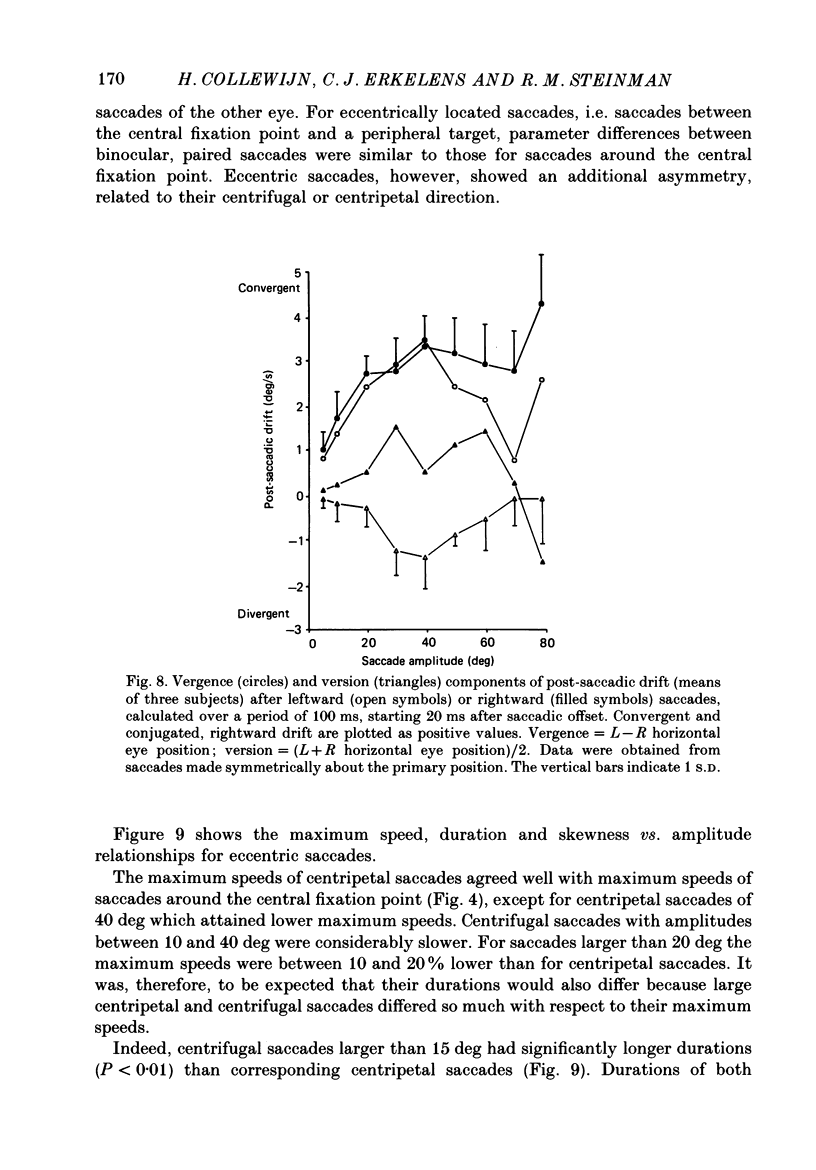
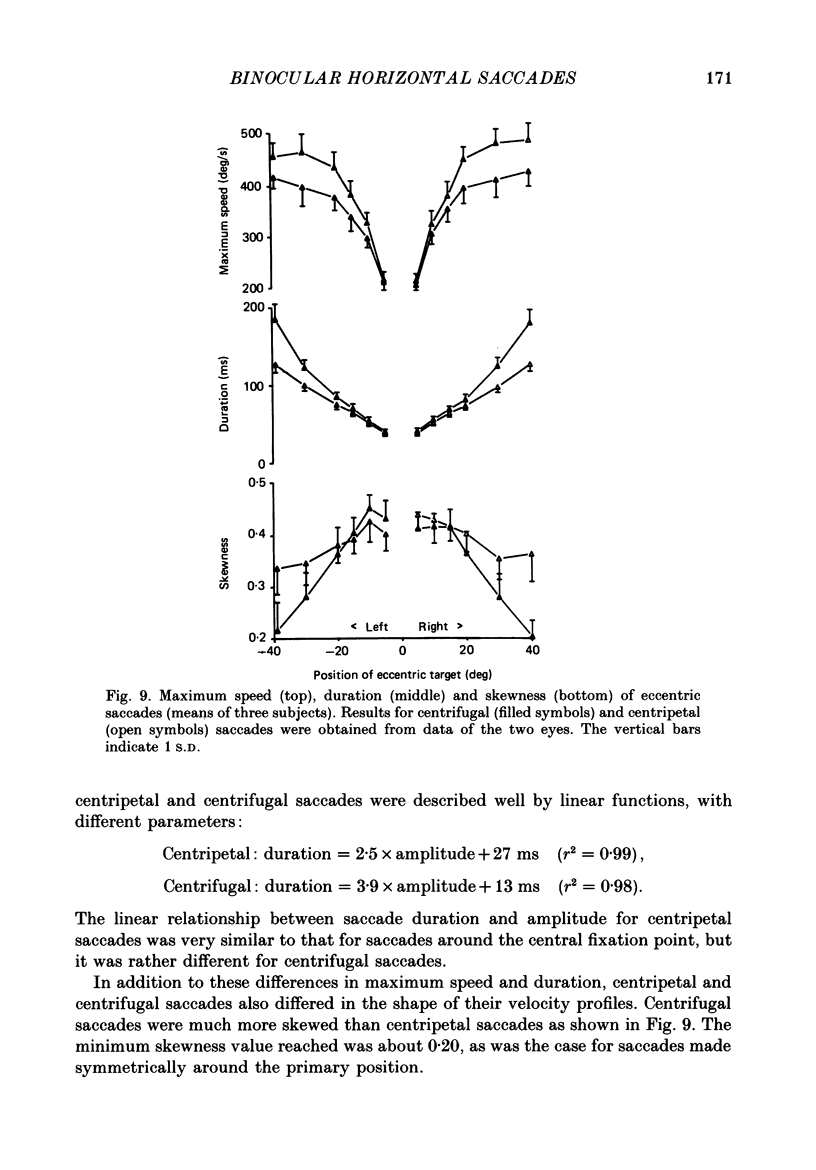
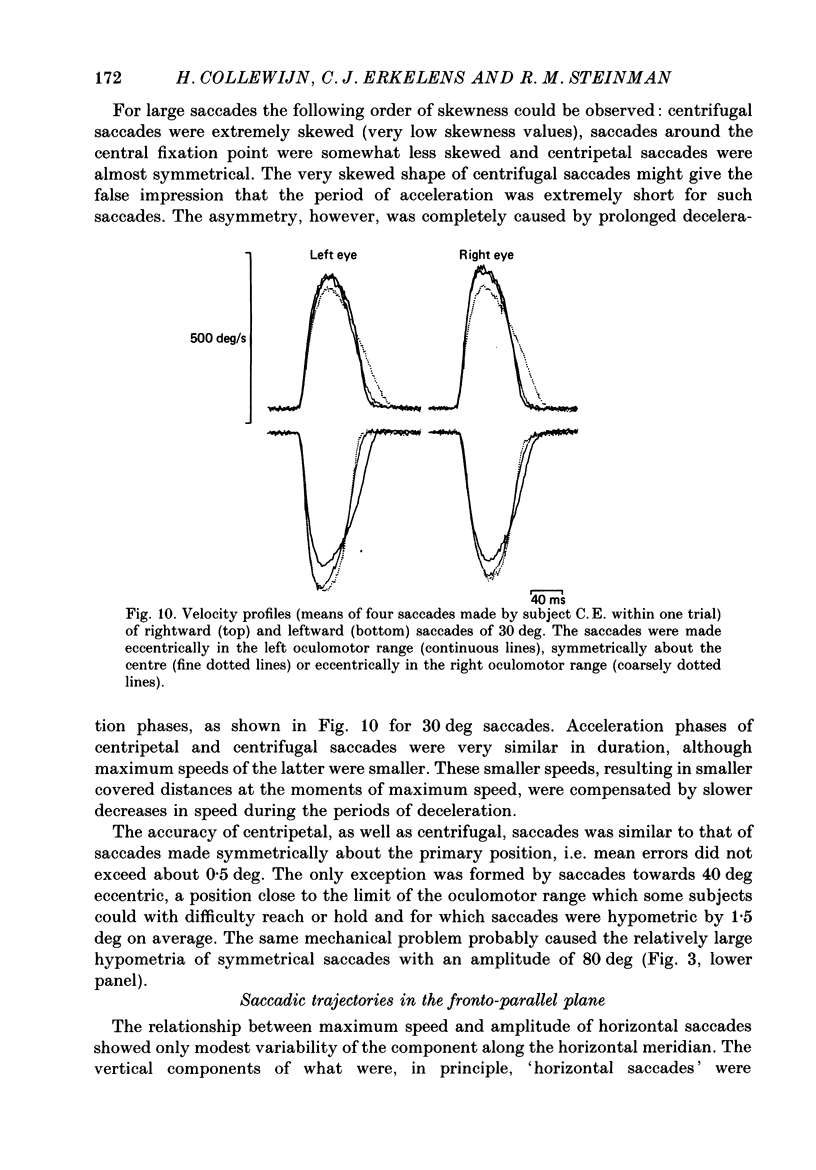
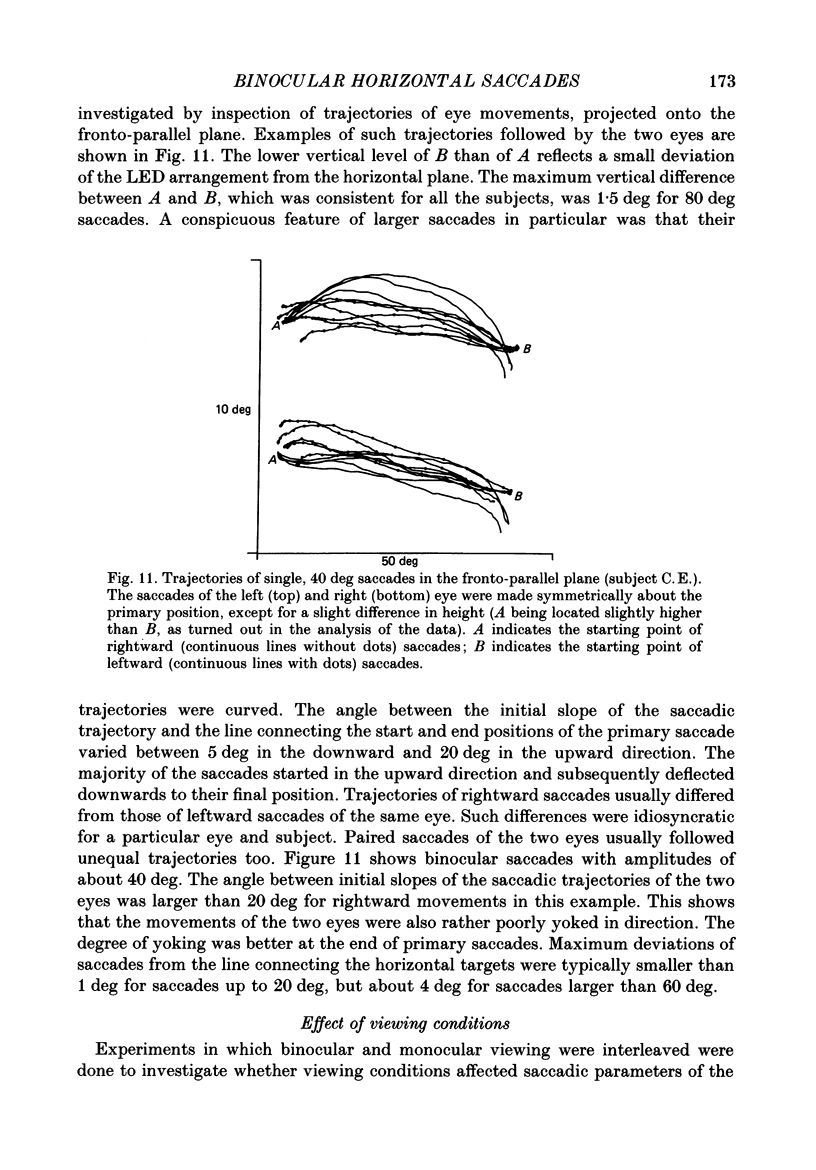
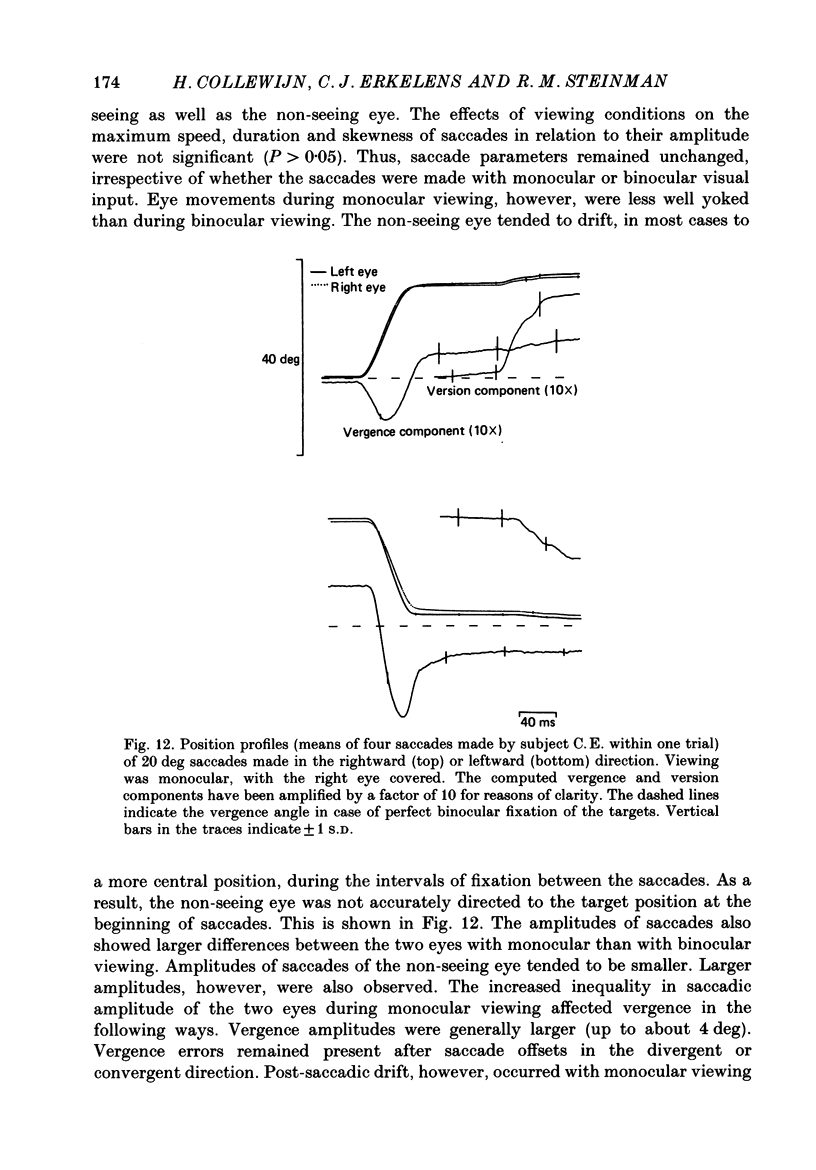

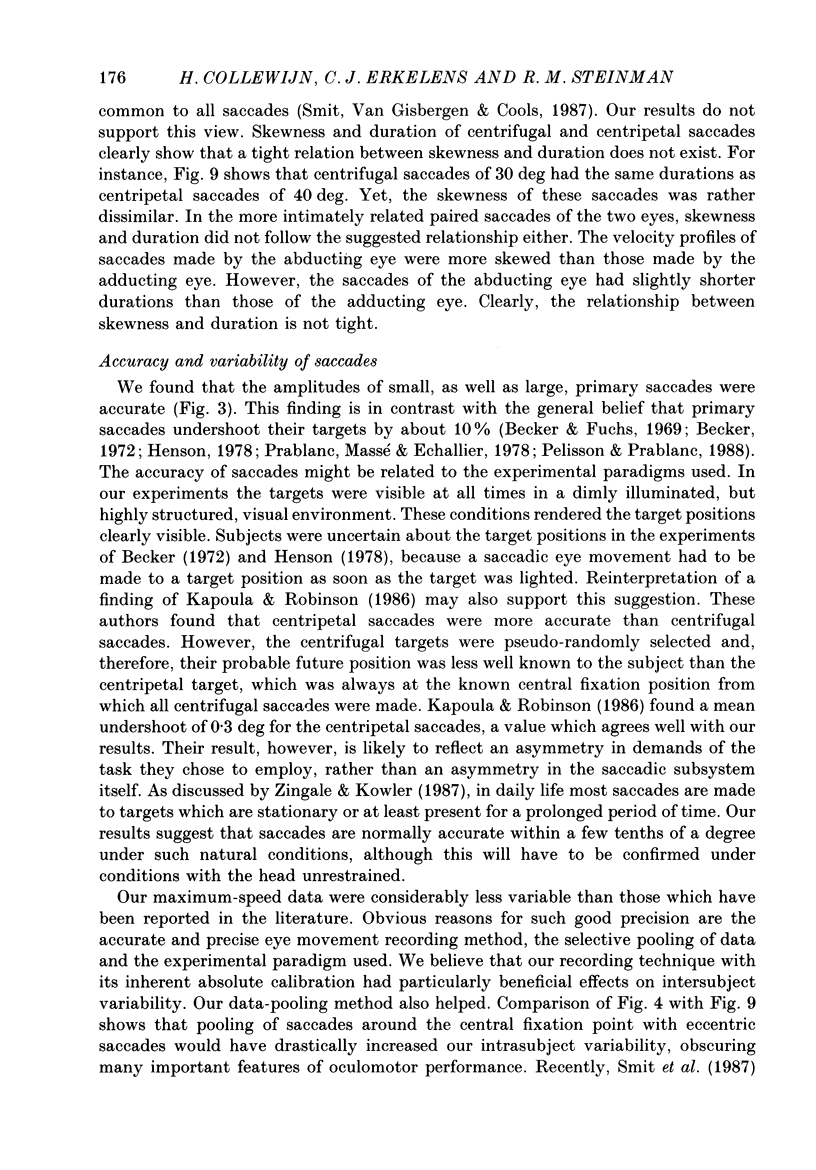
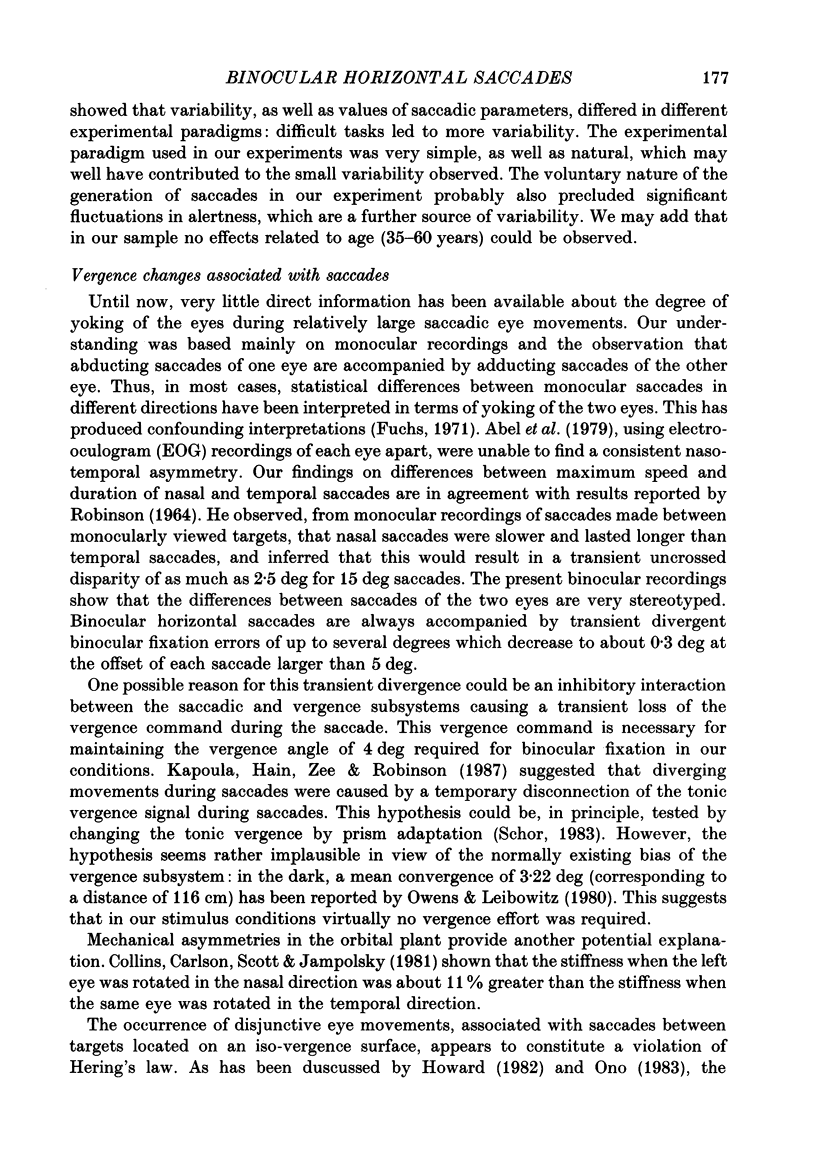


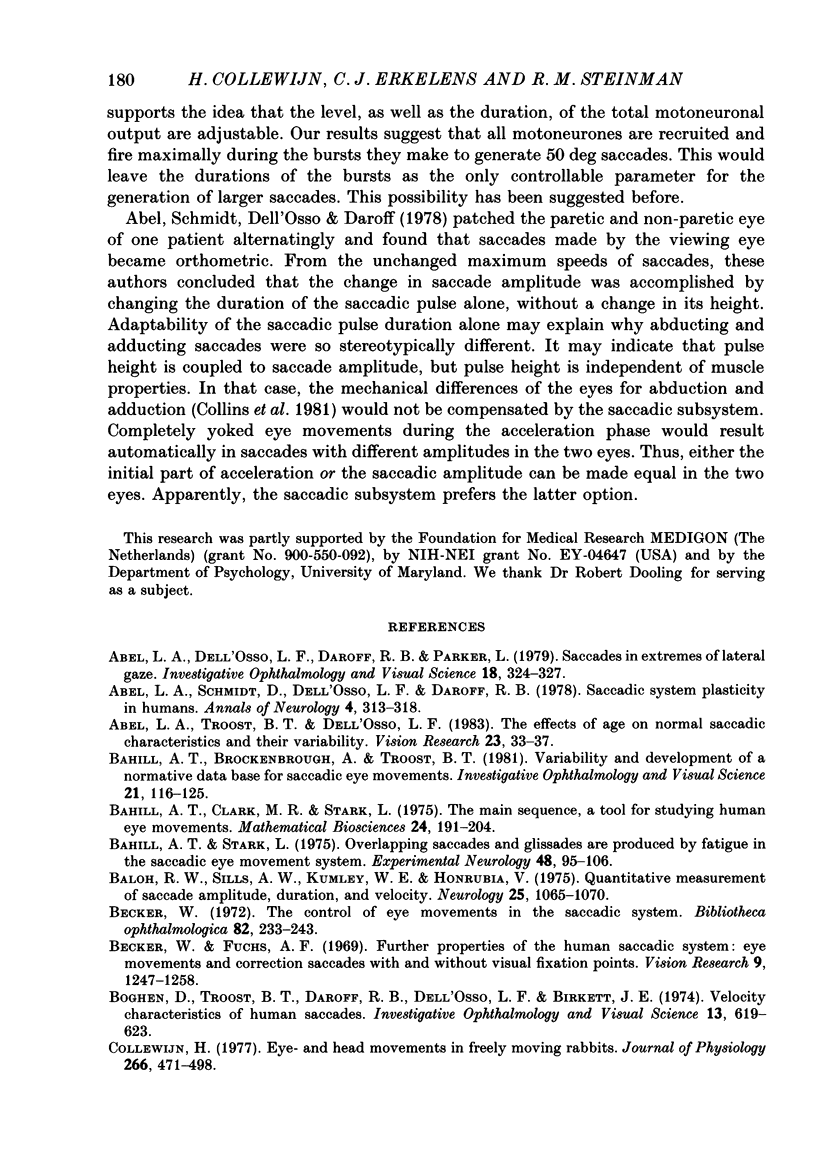

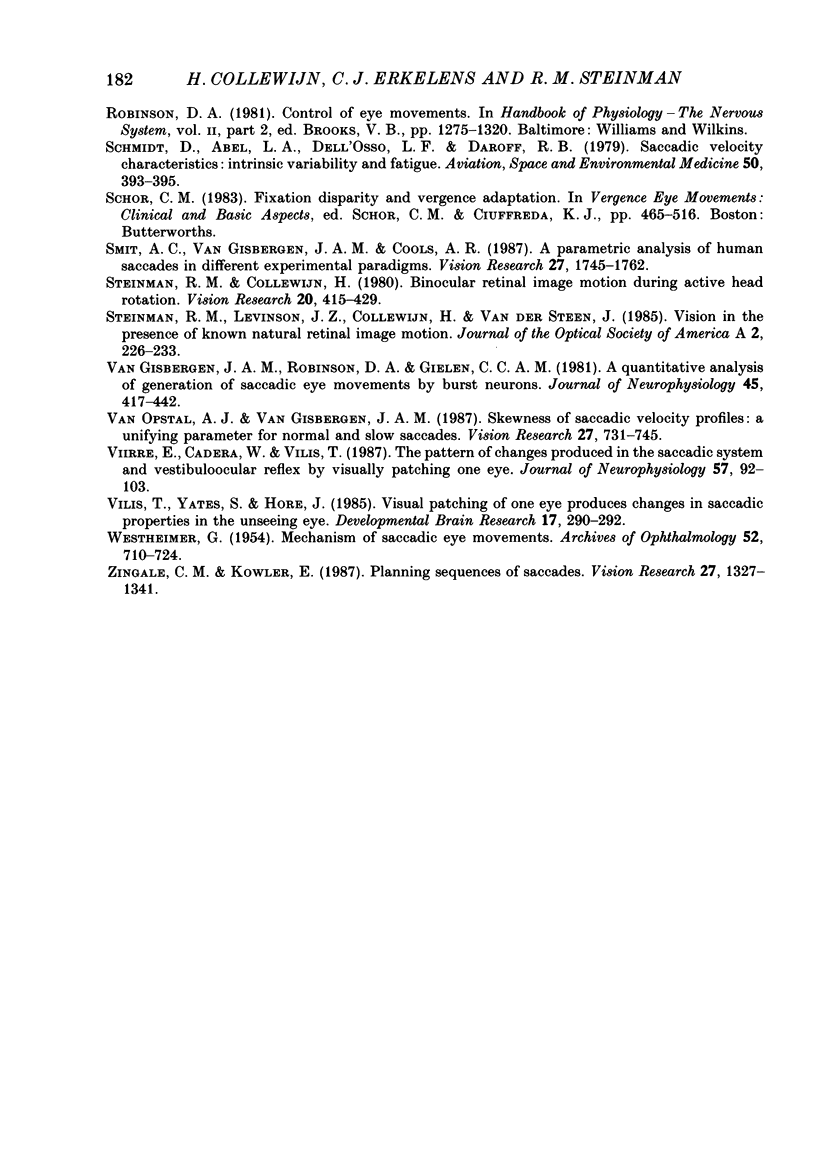
Selected References
These references are in PubMed. This may not be the complete list of references from this article.
- Abel L. A., Dell'Osso L. F., Daroff R. B., Parker L. Saccades in extremes of lateral gaze. Invest Ophthalmol Vis Sci. 1979 Mar;18(3):324–327. [PubMed] [Google Scholar]
- Abel L. A., Schmidt D., Dell'Osso L. F., Daroff R. B. Saccadic system plasticity in humans. Ann Neurol. 1978 Oct;4(4):313–318. doi: 10.1002/ana.410040405. [DOI] [PubMed] [Google Scholar]
- Abel L. A., Troost B. T., Dell'Osso L. F. The effects of age on normal saccadic characteristics and their variability. Vision Res. 1983;23(1):33–37. doi: 10.1016/0042-6989(83)90038-x. [DOI] [PubMed] [Google Scholar]
- Bahill A. T., Brockenbrough A., Troost B. T. Variability and development of a normative data base for saccadic eye movements. Invest Ophthalmol Vis Sci. 1981 Jul;21(1 Pt 1):116–125. [PubMed] [Google Scholar]
- Bahill A. T., Stark L. Overlapping saccades and glissades are produced by fatigue in the saccadic eye movement system. Exp Neurol. 1975 Jul;48(1):95–106. doi: 10.1016/0014-4886(75)90225-3. [DOI] [PubMed] [Google Scholar]
- Baloh R. W., Sills A. W., Kumley W. E., Honrubia V. Quantitative measurement of saccade amplitude, duration, and velocity. Neurology. 1975 Nov;25(11):1065–1070. doi: 10.1212/wnl.25.11.1065. [DOI] [PubMed] [Google Scholar]
- Becker W., Fuchs A. F. Further properties of the human saccadic system: eye movements and correction saccades with and without visual fixation points. Vision Res. 1969 Oct;9(10):1247–1258. doi: 10.1016/0042-6989(69)90112-6. [DOI] [PubMed] [Google Scholar]
- Becker W. The control of eye movements in the saccadic system. Bibl Ophthalmol. 1972;82:233–243. [PubMed] [Google Scholar]
- Boghen D., Troost B. T., Daroff R. B., Dell'Osso L. F., Birkett J. E. Velocity characteristics of normal human saccades. Invest Ophthalmol. 1974 Aug;13(8):619–623. [PubMed] [Google Scholar]
- Collewijn H., Erkelens C. J., Steinman R. M. Binocular co-ordination of human vertical saccadic eye movements. J Physiol. 1988 Oct;404:183–197. doi: 10.1113/jphysiol.1988.sp017285. [DOI] [PMC free article] [PubMed] [Google Scholar]
- Collewijn H. Eye- and head movements in freely moving rabbits. J Physiol. 1977 Apr;266(2):471–498. doi: 10.1113/jphysiol.1977.sp011778. [DOI] [PMC free article] [PubMed] [Google Scholar]
- Collewijn H., Martins A. J., Steinman R. M. Natural retinal image motion: origin and change. Ann N Y Acad Sci. 1981;374:312–329. doi: 10.1111/j.1749-6632.1981.tb30879.x. [DOI] [PubMed] [Google Scholar]
- Collewijn H., van der Mark F., Jansen T. C. Precise recording of human eye movements. Vision Res. 1975 Mar;15(3):447–450. doi: 10.1016/0042-6989(75)90098-x. [DOI] [PubMed] [Google Scholar]
- Collewijn H., van der Steen J., Steinman R. M. Human eye movements associated with blinks and prolonged eyelid closure. J Neurophysiol. 1985 Jul;54(1):11–27. doi: 10.1152/jn.1985.54.1.11. [DOI] [PubMed] [Google Scholar]
- Collins C. C., Carlson M. R., Scott A. B., Jampolsky A. Extraocular muscle forces in normal human subjects. Invest Ophthalmol Vis Sci. 1981 May;20(5):652–664. [PubMed] [Google Scholar]
- Cook G., Stark L., Zuber B. L. Horizontal eye movements studied with the on-line computer. Arch Ophthalmol. 1966 Oct;76(4):589–595. doi: 10.1001/archopht.1966.03850010591020. [DOI] [PubMed] [Google Scholar]
- Fricker S. J. Dynamic measurements of horizontal eye motion. I. Acceleration and velocity matrices. Invest Ophthalmol. 1971 Sep;10(9):724–732. [PubMed] [Google Scholar]
- Fuchs A. F., Binder M. D. Fatigue resistance of human extraocular muscles. J Neurophysiol. 1983 Jan;49(1):28–34. doi: 10.1152/jn.1983.49.1.28. [DOI] [PubMed] [Google Scholar]
- Fuchs A. F., Luschei E. S. Firing patterns of abducens neurons of alert monkeys in relationship to horizontal eye movement. J Neurophysiol. 1970 May;33(3):382–392. doi: 10.1152/jn.1970.33.3.382. [DOI] [PubMed] [Google Scholar]
- HYDE J. E. Some characteristics of voluntary human ocular movements in the horizontal plane. Am J Ophthalmol. 1959 Jul;48(1 Pt 1):85–94. doi: 10.1016/0002-9394(59)90290-9. [DOI] [PubMed] [Google Scholar]
- Henson D. B. Corrective saccades: effects of altering visual feedback. Vision Res. 1978;18(1):63–67. doi: 10.1016/0042-6989(78)90078-0. [DOI] [PubMed] [Google Scholar]
- Jürgens R., Becker W., Kornhuber H. H. Natural and drug-induced variations of velocity and duration of human saccadic eye movements: evidence for a control of the neural pulse generator by local feedback. Biol Cybern. 1981;39(2):87–96. doi: 10.1007/BF00336734. [DOI] [PubMed] [Google Scholar]
- Kapoula Z., Hain T. C., Zee D. S., Robinson D. A. Adaptive changes in post-saccadic drift induced by patching one eye. Vision Res. 1987;27(8):1299–1307. doi: 10.1016/0042-6989(87)90207-0. [DOI] [PubMed] [Google Scholar]
- Kapoula Z., Robinson D. A. Saccadic undershoot is not inevitable: saccades can be accurate. Vision Res. 1986;26(5):735–743. doi: 10.1016/0042-6989(86)90087-8. [DOI] [PubMed] [Google Scholar]
- Owens D. A., Liebowitz H. W. Accommodation, convergence, and distance perception in low illumination. Am J Optom Physiol Opt. 1980 Sep;57(9):540–550. doi: 10.1097/00006324-198009000-00004. [DOI] [PubMed] [Google Scholar]
- Pelisson D., Prablanc C. Kinematics of centrifugal and centripetal saccadic eye movements in man. Vision Res. 1988;28(1):87–94. [PubMed] [Google Scholar]
- Prablanc C., Massé D., Echallier J. F. Error-correcting mechanisms in large saccades. Vision Res. 1978;18(5):557–560. doi: 10.1016/0042-6989(78)90202-x. [DOI] [PubMed] [Google Scholar]
- ROBINSON D. A. THE MECHANICS OF HUMAN SACCADIC EYE MOVEMENT. J Physiol. 1964 Nov;174:245–264. doi: 10.1113/jphysiol.1964.sp007485. [DOI] [PMC free article] [PubMed] [Google Scholar]
- Regan D., Erkelens C. J., Collewijn H. Necessary conditions for the perception of motion in depth. Invest Ophthalmol Vis Sci. 1986 Apr;27(4):584–597. [PubMed] [Google Scholar]
- Robinson D. A. Oculomotor unit behavior in the monkey. J Neurophysiol. 1970 May;33(3):393–403. doi: 10.1152/jn.1970.33.3.393. [DOI] [PubMed] [Google Scholar]
- Schmidt D., Abel L. A., Dell'Osso L. F., Daroff R. B. Saccadic velocity characteristics: intrinsic variability and fatigue. Aviat Space Environ Med. 1979 Apr;50(4):393–395. [PubMed] [Google Scholar]
- Smit A. C., Van Gisbergen J. A., Cools A. R. A parametric analysis of human saccades in different experimental paradigms. Vision Res. 1987;27(10):1745–1762. doi: 10.1016/0042-6989(87)90104-0. [DOI] [PubMed] [Google Scholar]
- Steinman R. M., Collewijn H. Binocular retinal image motion during active head rotation. Vision Res. 1980;20(5):415–429. doi: 10.1016/0042-6989(80)90032-2. [DOI] [PubMed] [Google Scholar]
- Steinman R. M., Levinson J. Z., Collewijn H., van der Steen J. Vision in the presence of known natural retinal image motion. J Opt Soc Am A. 1985 Feb;2(2):226–233. doi: 10.1364/josaa.2.000226. [DOI] [PubMed] [Google Scholar]
- Van Gisbergen J. A., Robinson D. A., Gielen S. A quantitative analysis of generation of saccadic eye movements by burst neurons. J Neurophysiol. 1981 Mar;45(3):417–442. doi: 10.1152/jn.1981.45.3.417. [DOI] [PubMed] [Google Scholar]
- Van Opstal A. J., Van Gisbergen J. A. Skewness of saccadic velocity profiles: a unifying parameter for normal and slow saccades. Vision Res. 1987;27(5):731–745. doi: 10.1016/0042-6989(87)90071-x. [DOI] [PubMed] [Google Scholar]
- Viirre E., Cadera W., Vilis T. The pattern of changes produced in the saccadic system and vestibuloocular reflex by visually patching one eye. J Neurophysiol. 1987 Jan;57(1):92–103. doi: 10.1152/jn.1987.57.1.92. [DOI] [PubMed] [Google Scholar]
- Vilis T., Yates S., Hore J. Visual patching of one eye produces changes in saccadic properties in the unseeing eye. Brain Res. 1985 Jan;349(1-2):290–292. doi: 10.1016/0165-3806(85)90157-9. [DOI] [PubMed] [Google Scholar]
- WESTHEIMER G. Mechanism of saccadic eye movements. AMA Arch Ophthalmol. 1954 Nov;52(5):710–724. doi: 10.1001/archopht.1954.00920050716006. [DOI] [PubMed] [Google Scholar]
- Zingale C. M., Kowler E. Planning sequences of saccades. Vision Res. 1987;27(8):1327–1341. doi: 10.1016/0042-6989(87)90210-0. [DOI] [PubMed] [Google Scholar]


